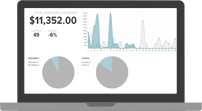In this blog, we're going to talk about some of the ways church leaders can use giving data to spot actionable trends in their church. Two things this blog post is not:
- This is not about handling donation data from a security or privacy standpoint.
- This is not about trends for non-profit organizations (as opposed to churches).
These are both important topics, and probably something we'll cover in future blog posts, but this is specifically for church leaders and data trends. That being said, let's jump into it:
Insightful, actionable reporting
One of the most important ways a donation management system can help a church grow is by empowering church leaders by organizing data and providing insightful reports. Most donation programs are simple transaction-gatherers: they accept a donation online or mobile, maybe have a list of transactions or a graph or two, and that's it.
We tend to build our reporting functions for two types of people: the accountant and the church planter. In other words, we want an accountant to dive deeply into as many complex reports as possible, but a church planter with no background in business or finance should be able to log in and see easy-to-understand reports on a variety of topics - donor activity, recurring donation trends, overall growth (or decline) and so on. If your reporting takes a degree to decipher or can't lead to immediate action - it's too complex.
Spotting trends & issues
We live in a strange new world of data collection and management, where Google and Facebook know more about a church’s congregation than the pastors do. Most pastors have just a few points of data on their congregation – attendance, giving, and maybe baptisms. No one is saying pastors need to track their congregation as minutely as Facebook does, but looking at giving data and finding trends can be incredibly helpful in measuring the overall and individual health of the church.
Consider the following scenario: over the past six months, attendance at your church has increased 25%. In that same period, giving has also increased 25%. That sounds right, but on closer inspection, all of the increase in giving has come from existing donors – none of the new attendees are giving. This may indicate that the new visitors to the church feel marginalized and not part of the larger community, and may soon leave.
Furthermore, seeing giving trends can help alert pastors to individual needs. In times of crisis or conflict, many church members won’t consult a pastor or fill out a comment card – they just leave and don’t come back. Say a member had an argument with their community group leader and decided to leave the church. Their pastor might not even know until it’s too late – unless they saw the abrupt cancellation of their tithe, followed up, and sought reconciliation between the two parties.
I'm not saying that analyzing trends and data should replace discipleship - but I do think it's another tool meant to empower church leaders to bless their congregation. I'd love to hear your thoughts - good or bad - or if you'd like to hear more about how to implement some of these practices in your church, email me at john@givingfire.com. I'd love to talk!
New to GivingFire?
We're passionate about solid donation management for churches and non-profits, and we're trying to bring honesty and transparency to a murky industry. If you need help figuring out donations, we'd love to talk.
Contact us HERE or take a look at our main site at givingfire.com.



